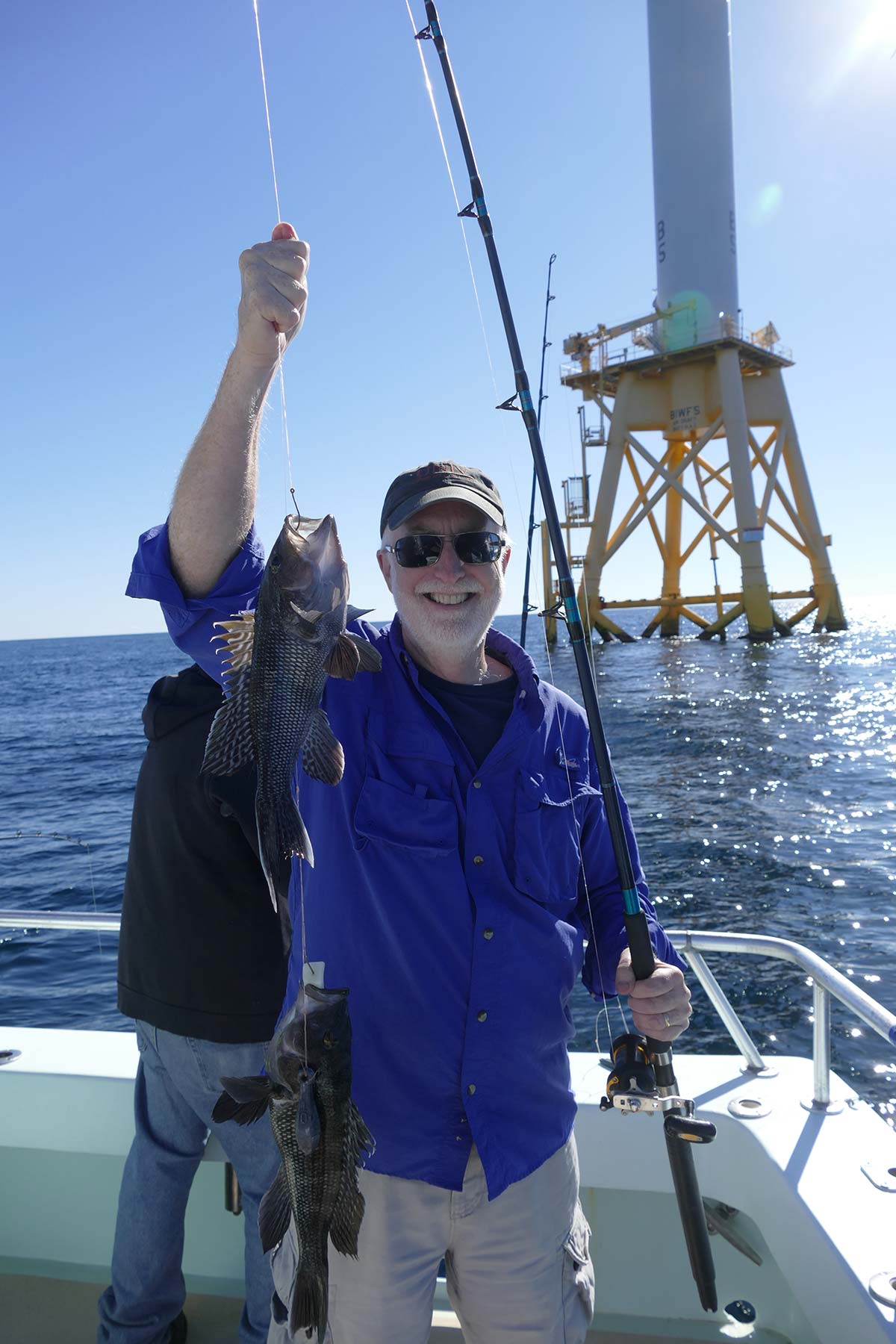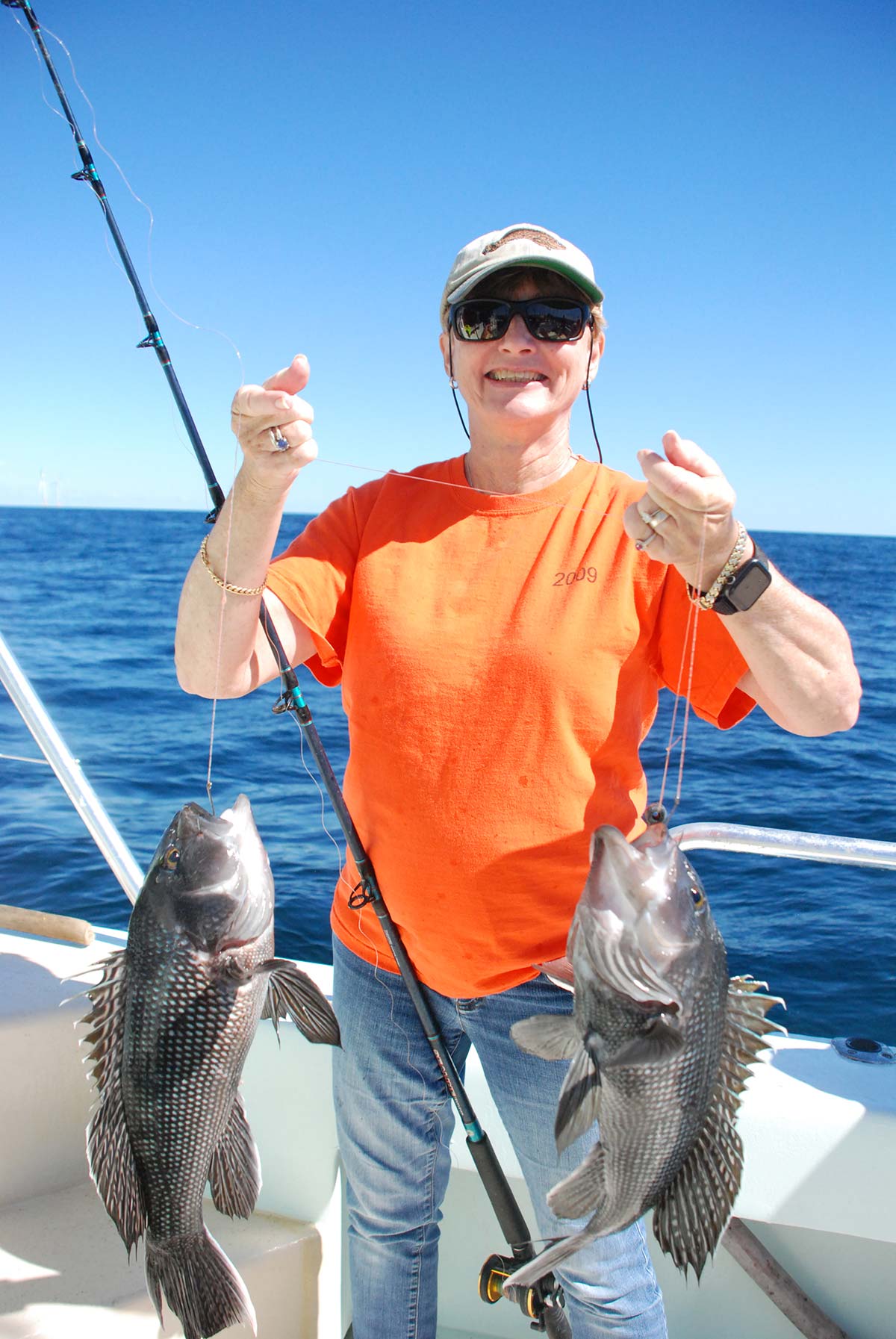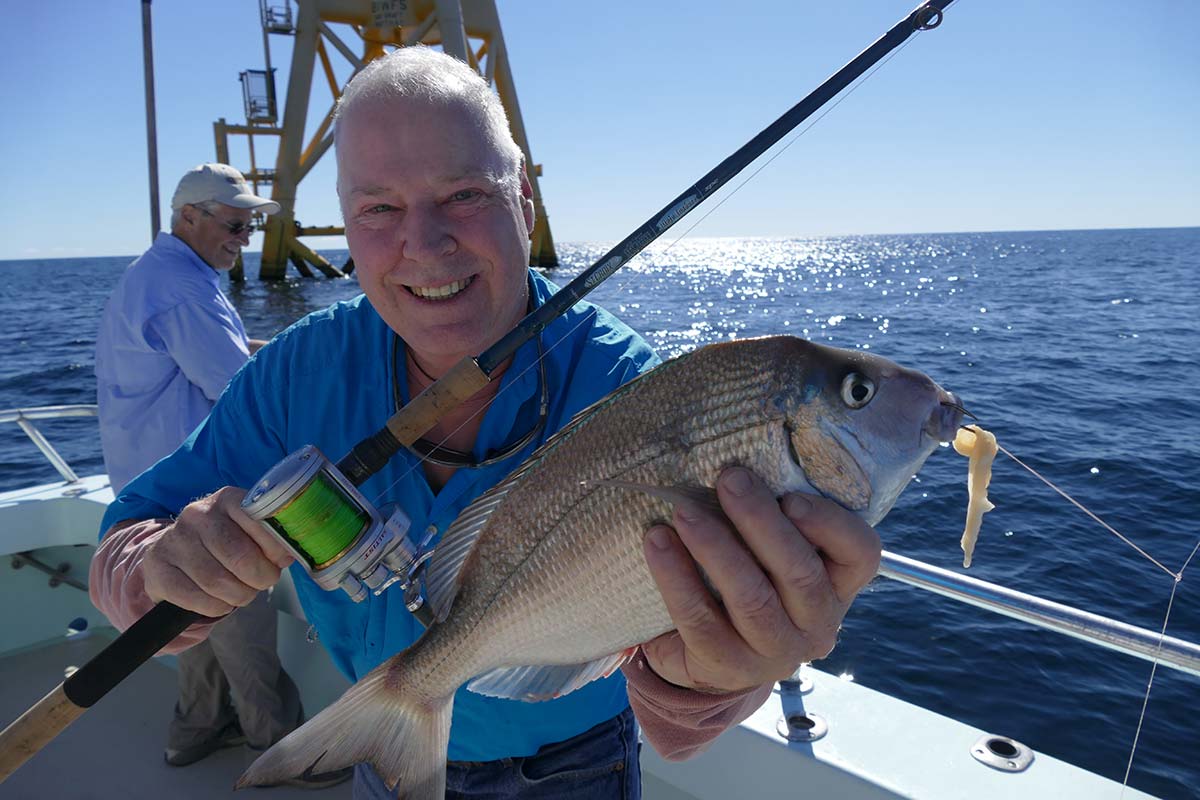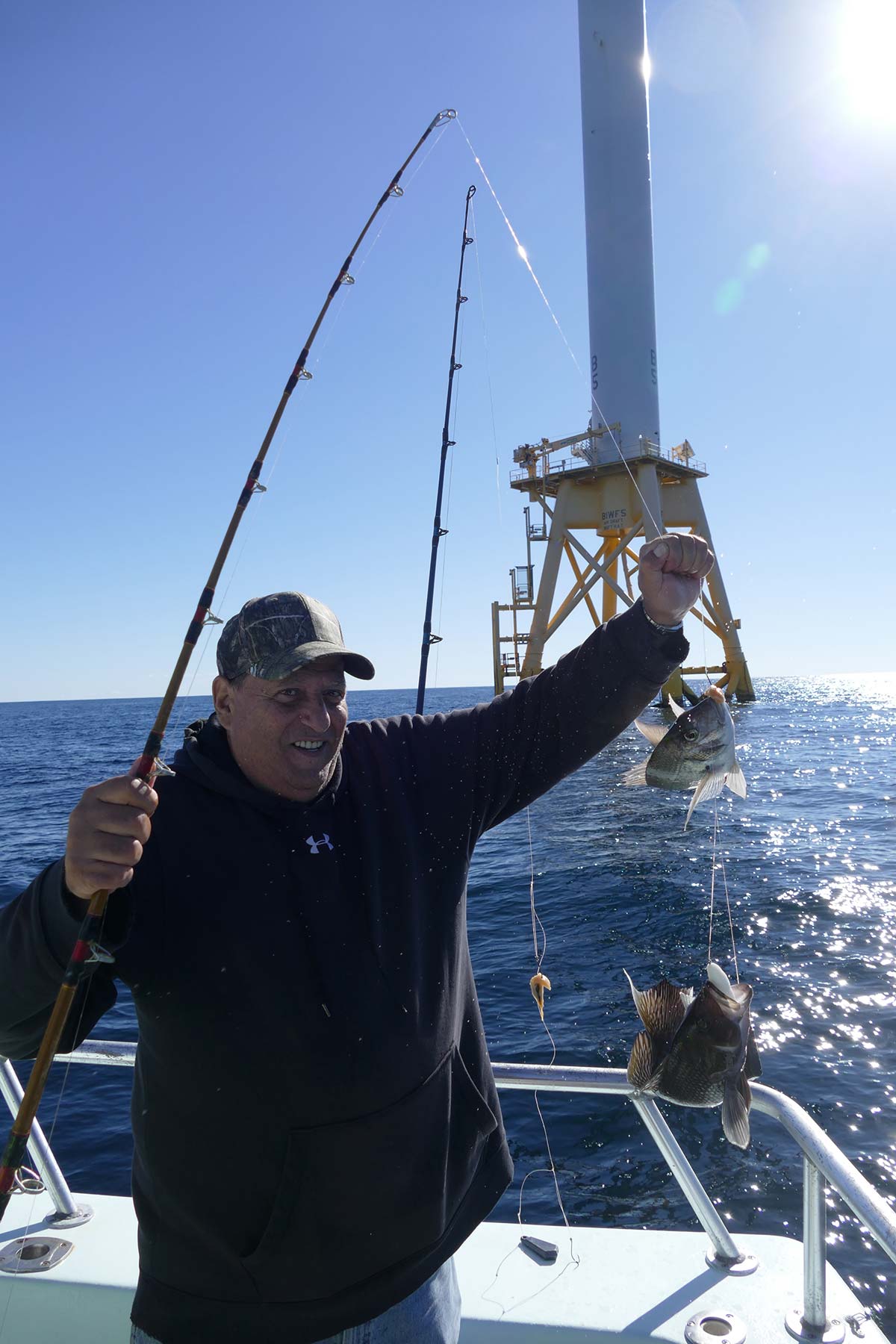
Get up close and personal with these structures for banner fishing.
It was seven in the morning and the weather was perfect; not a cloud in the sky, a breeze from the east at five knots with an air temperature of 72 degrees. Captain Steven Forsberg, a fourth generation Montauk charter captain, was at the wheel of the Viking Five Star, a custom built 65-foot charter boat as we broke the Montauk jetties and headed east, bound for the Block Island Wind Farm The water was about 90 feet deep and we were about 12 miles east of Montauk and three miles southeast of Block Island. It was shaping up to be a perfect day of fishing.
Completed in 2016, the Block Island Wind Farm, operated by the offshore wind developer Orsted; consists of five turbines reaching heights of approximately 600 feet, and each capable of producing six megawatts of electricity for a total project scale of 30 megawatts, enough to power 17,000 homes. The turbines connect to New Shoreham, Rhode Island via a submarine power cable buried in the sea floor.

Exploring The Farm
Having heard stories of the great fishing that existed around the base of each turbine, I decided to see for myself if the rumors were true, and so I put together a small group of experienced charter boat captains and bottom fishermen. Together, we set off on an exploratory trip to the offshore wind farm.
“Get as close to the foundation as possible,” I instructed Captain Steve as we approached wind turbine number five, while the six anglers on deck baited their 5/0 hooks, spaced three feet apart, on hi-lo rigs, with cut squid and clam.
Expertly positioning the stern about 30 yards away from the steel legs that made up the foundation of the turbine, Captain Steve shouted out of the wheelhouse door “Let ‘em go”, and six rigs, pulled by 10-ounce sinkers were free spooled to the bottom.
Having heard rumors of large black sea bass and porgies prowling around the base of each of the five foundations, anticipation was high as we drifted past the rig, then, suddenly, as soon as we got downtide of the foundation and if on que, shouts of “fish on” were heard across the stern as everyone raced to be the first to have a fish on deck. Richie Dodaro, my long-time fishing and hunting partner, was the first to swing his catch aboard, a doubleheader, made up of a 3-1/2-pound porgy and a 3-pound black sea bass. Andy Schau, my cousin, quickly followed lifting a doubleheader of 3-pound black sea bass over the stern, while my wife, LuAnn, continued the action swinging her own pair of jumbo 5-pound sea bass over the rail.
Everyone had fish on—the bite was incredible—as soon as you hit bottom you had a bite! Each drift past the foundation would produce, porgies, sea bass and fluke. The action would continue to be fast and furious until we drifted about o100 yards away from the turbine foundation, after which the bite would slow down and we’d just run up tide for another drift. Someone suggested why not just tie up to the rig instead of drifting past them, but I quickly reminded them that while drifting past and fishing the turbines was allowed by the Coast Guard, tying up to one, was not. Someone else suggested that, in the future, the new increasingly popular “GPS anchors”, a bow mounted trolling motor with internal or interfaced GPS modules, designed to hold a boat in place without the need of deploying a traditional anchor, were perfectly suited to fishing alongside a turbine foundation, with the added benefit of eliminating the risk of getting stuck on the bottom. Everyone agreed that would be the way to go in the future instead of drifting.

Try One, Try All
After a few drifts, and reminding everyone of our original goal to test the fishing next to each turbine, it was time to move on to turbine number four to see if it would also produce.
The old saying, “You never leave fish to find fish” was on everyone’s mind as we sailed away from turbine number five and approached number four; but those fears were soon gone as shouts of “fish on” were heard again as soon as the rigs hit the bottom next to turbine number four. As the “official photographer” for the trip, it was my job to document the fishing but I could not resist the temptation to fish and gave in, putting down the camera and picking up a rod rigged with a 3-ounce single hook Tsunami jig in silver. I flipped the jig to the turbine foundation, and within three snaps of the rod tip, I was into an 8-pound bluefish.
On and on it went with each turbine producing a catch of fish that would make anyone happy. Curiously, some turbines seemed to hold an even mix of species, while others would be mostly porgies or sea bass. A couple of turbines had schools of anchovies swimming in amongst the foundation legs and these were the turbines that held the bluefish.

Above And Below
Weeks later, in a conversation with Skip Feller, captain of the head-boat Rudee Angler, he told me the two recently installed turbines, 23 miles offshore of Virginia Beach, were attracting pelagic baitfish. These baitfish were attracting mahi-mahi, cobia and amberjack. The rock placed around the base of each turbine, known as “scour protection”, designed to prevent the sand from washing out from under the turbine, was holding the typical Virginia bottom species consisting of sea bass, fluke and spadefish. He told me he could not wait for more turbines to be built, so he could fish the topwater for the mahi’s and the bottom on the scour protection that comes with each turbine. In his opinion, an area of plain sandy bottom that he used to only travel through has now become a destination as each turbine develops into an artificial reef.
Recently, underwater videos of the Block Island turbines show the legs of each foundation covered with mussels and fish picking at them. It seems each turbine develops its own food chain and that chain attracts many species popular with local recreational anglers.
| LEARN MORE |
| Fishermen wishing to learn more about the science of why the foundations attract fish and what is called the “Artificial Reef Effect” should turn on their computers and click on the ‘Learning from the Experts’ webinar series sponsored by the New York State Energy Research Development Authority, also known as NYSERDA, and watch the segment titled “Environmental Considerations For Fixed Offshore Wind Foundation Technologies”. |
By 1 p.m. we had reached our September sea bass limit and we had all the jumbo porgies we could use, and so it was time to steam back to Montauk. Jay our deckhand, kept busy the entire return trip filleting fish, finishing the last porgy just as we passed the jetties marking the entrance to Montauk harbor.
All in all, it was the perfect day, great weather, good friends, and incredible fishing. What more could one ask for?
With hundreds of additional turbines scheduled to be erected in the near future from Martha’s Vineyard to Cape Hatteras, several offshore of Long Island and New Jersey, recreational fishermen should hope these new turbines will produce the same action as the Block Island and Virginia Beach wind farms. If they do, get ready, there is some great fishing in our future!


